IN THIS ARTICLE
Multiplayer Network Entity Hierarchies
Network Hierarchies provide a convenient way to group related entities under one logical group. Entities in such a hierarchy process their network input together as one, including their input creation, processing and rollback.
Important:Network Hierarchies are designed for small groups of entities.
By default the limit is set to 16 entities. You can modify this limit with CVar:
bg_hierarchyEntityMaxLimit.
Hierarchical Components
In order to declare a network hierarchy, you have to use a combination of hierarchical components: NetworkHierarchyRootComponent and NetworkHierarchyChildComponent. NetworkHierarchyRootComponent marks an entity as the root of a hierarchy and it should be placed on the highest parent of your entity prefab or a group of entities. NetworkHierarchyRootComponent marks an entity as a child of a hierarchy. It should be added on child entities under the entity with NetworkHierarchyRootComponent.
Network hierarchies can be created either in the Editor or by parenting entities at runtime.
Creating Network Hierarchies in the Editor
Creating a network entity with all its network common components:
- Network Binding Component
- Network Transform Component
Add a Mesh component for visual information in the Editor.
Here is an example of a simple network entity:
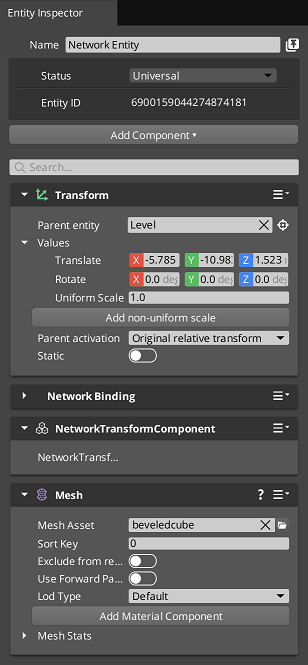
To make it a hierarchical root entity, add a Network Hierarchy Root component:
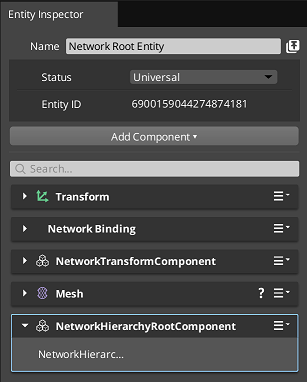
The resulting entity is a parent entity for hierarchical child entities.
Form a hierarchical child entity by adding a Network Hierarchy Child component:
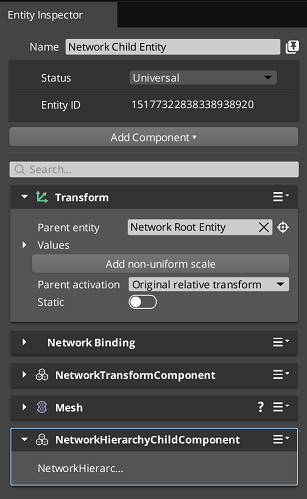
Notice that this entity is a child entity to the root entity.
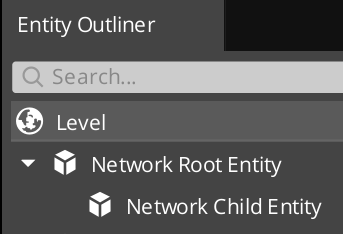
Often, a hierarchy is a group of entities that you want to spawn at runtime. In these cases, you want to create a prefab out of the entities.

It is important that the entity with a Network Hierarchy Root component is at the top parent entity within the prefab. All other entities should have a Network Hierarchy Child component on them.
ImGui Hierarchy Debugger
O3DE Multiplayer Gem comes with a debugger to help you trouble shoot and analyze hierarchy structure in an O3DE application. It can be enabled by bringing up ImGui menu (HOME key by default), and then selecting Multiplayer > Multiplayer Hierarchy Debugger. With the hierarchy debugger enabled, you will be able to browse hierarchies and get debug text in the world over the root entities of hierarchies.
Using this debugger, you can find the following information about a hierarchy:
- Its root entity name
- Total number of entities in the hierarchy
- Entity name of each member within the hierarchy
- The
AZ::EntityIdof each member - The network ID of each member,
Multiplayer::NetEntityId - Its hierarchical role within the hierarchy, either child, root, or an inner root that acts as a child in the case of nested hierarchies.
Adding Input Processing to Network Hierarchies
Any entity that has component(s) that perform multiplayer input processing component need to have either:
- Local Prediction Input
- Network Hierarchy Root
- Network Hierarchy Child
For example, here is an example component that has a NetworkInput field in its definition.
<?xml version="1.0"?>
<Component
Name="NetworkInputProcessingExampleComponent"
Namespace="MultiplayerSample"
OverrideComponent="false"
OverrideController="false"
xmlns:xsi="http://www.w3.org/2001/XMLSchema-instance">
<NetworkInput Type="float" Name="InputValue" Init="0.0f" />
</Component>
Add a component to provide multiplayer input processing:
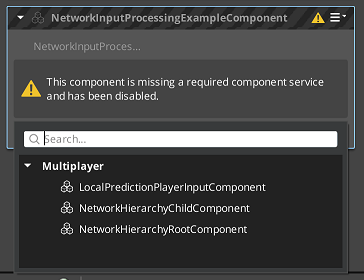
As a general rule, a hierarchy must have one Local Prediction Input component at its top parent entity to process multiplayer input. However, hierarchical child entities need only a Network Hierarchy Child component to process their multiplayer input.
Creating Network Hierarchies at Runtime
Network hierarchies are automatically updated, created and disbanded at runtime whenever parent-child relationship changes among entities with either a hierarchy root or hierarchy child component. When the AZ::TransformBus EBus is used to change the attachments of entities, the hierarchies are updated at runtime.
Hierarchies of Hierarchies
It is possible to create a hierarchy out of several hierarchies by attaching the root of one hierarchy to an entity from another hierarchy. In such cases, an inner root component becomes a hierarchical child of this new parent, until it is detached from the hierarchy. This is useful when constructing vehicles, weapons and players out of different prefabs that are attached and detached at runtime as needed.
Note:For more information on network hierarchies, read the ServerHierarchyTests source .
